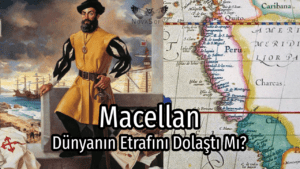The Landing of the Russians in the Mediterranean (X-XI. Century)

When the Varangians came from beyond the sea and established their rule over the Slavic cities, the foundations of the Kievan Rus’, the first Russian state, were laid. In addition to the Varangians being a seafaring people,[1] Slavic tribes were also barrage in areas of Eastern Europe close to waterways.
In this context, the Russians, who emerged as a mixture of Slavic-Varangian identity, were primarily familiar with maritime. As a matter of fact, the Russians organized around Kiev came to Constantinople and traded with Byzantium. Arab travelers of the Xth century wrote that the Black Sea was a Russian sea.
The Russians, who saw the Black Sea as their own sea, enlarged their targets over time. The next target of the Russian merchants, who sailed from the Black Sea to the Sea of Marmara, was the Mediterranean[2].
First, the Varangians/Russians were introduced to the Mediterranean world in the IX century. Arab writers wrote that during this century, the Russians, under the leadership of a man named Ashold, attacked Seville.
At the same time, the Russians served the Byzantine Emperors for money. After completing their service, the Russians either returned to their own lands by boat or sailed to the Mediterranean[3].
The Russians’ relations with the Byzantine Empire were not based solely on trade or service. From time to time, the Russians raided Constantinople.
According to the first chronicle of the Russians, Povest Vremennih Let, a Russian attack was made on Constantinople in 860 with a fleet of 200 ships. Another attack was seen during Oleg’s reign. In 907, Oleg took with him the Varangians, Slavs, Chauds, Krivics, Merians, Polyans, Lovers, Drevlyans, Radimichs, Croats, Dulebians, and Tiversians, and set out with his horses and ships. The target was Constantinople, which they called Tsargrad. The number of their ships was about two thousand.
There were forty people on each ship. When they arrived in front of Tsargrad,[4] the Byzantines had closed the gates of the city. Oleg and his companions landed and carried out a great massacre and plunder. Meanwhile, Oleg ordered his men to make large wheels and attach them to the ships. Thus they marched the ships overland and besieged Constantinople[5].
As a result of this siege, the treaty in favor of the Russians was made and this treaty was renewed in 912. Igor of Russia, also from the Russian knez, made a new treaty with Byzantium in 944. These agreements ensured that the Russians strengthened their hand at sea and opened up to the Mediterranean through the Bosphorus.
In the X-XI centuries, some Russians were working as mercenaries in the Byzantine navies. For example, 700 Russian soldiers fought against the Arabs in Crete in 902. Also in 936, 415 Russian soldiers participated in the Byzantine expedition to Italy. In 949, the expedition to Crete was attended by 9 fleets of 629 soldiers of the Russians. Of course, these navies were not owned by the Kiev State, but were chartered navies belonging to seafaring Russians[6].
The Mongol domination that emerged in Russia from the XIII century onwards and the subsequent activity of the Crimean Khanate on the northern shores of the Black Sea dealt a blow to the communication of the Russians with the Mediterranean world. Because the Russians’ roads to the Black Sea and the Mediterranean were cut off by the Turkish-Tatars. The Ottoman Empire was also aware of the commercial importance of the Crimean ports.
After Fatih Sultan Mehmet captured Istanbul and gained control of the straits, he conquered the Crimean ports of economic importance under the rule of the Genoese and Venetians and tried to turn the Black Sea into a Turkish lake. For this purpose, he conquered Amasra, Sinop and Trabzon in 1461, organized campaigns to Kefe in 1475 and Boğdan in 1476[7].
Again, due to the commercial importance of the Black Sea, he ensured that the Crimean Khanate, which was in a strategic position, came under Ottoman protection. Thus, Russia’s contact with the Black Sea was cut off[8]. As a result, the plans of the Russians to land on the warm seas, which would last for centuries, began.
[1] Varangians were warrior traders who tried to dominate the trade routes through the lands inhabited by the Scandinavian Vikings or Slavic, Baltic and Finno-Ugric tribes. They settled on the eastern side of the Baltic Sea and from there made their way inland through waterways. See Geoffrey Hosking, Russia and the Russians; Early to 21. Yüzyıla, Istanbul, 2015, p. 52.
[2] Leyla Darwish, Khalida Devrisheva, “The Background of Tsarist Russia’s Mediterranean Policy”, Cedrus, Vol. III, 2015, p. 353.
[3] A. B. Şirokorad, Rossiya na Sredizemnom More, Moskva, 2013, s. 6.
[4] It is the name given to Constantinople by the Russians in the early period. The concept, which is a combination of the words tsar and gorod, that is, tsar and city, means “Tsar city”.
[5] The Russian Primary Chronicle, Laurentian Text, Trans. and Ed. Samuel Hazzard Cross, P. Sherbowitz-Wetzor, Cambridge, 1953, s. 64-65; Povest Vremennıh Let, Per. D. S. Lihaçev, O. V. Tvorogov, St. Petersburg, 2012, s. 23-24; Geoffrey Hosking, a.g.e., s. 56. Erken dönemde Rus denizcilik faaliyetleri için bkz. V. V. Mavrodin, Naçalo Morehodstva na Rusi, Leningrad, 1950.
[6] Leyla Darwish, Khalida Devrisheva, op. cit., p. 354.
[7] Halil İnalcık, “The Entry of the Crimean Khanate into Ottoman Subordination According to the New Documents and the Question of Ahidname”, Belleten, Vol. VIII, No. 30, p. 193.
[8] A. B. Shirokorad, op. cit., p. 6; Haydar Efe, Murat Kızıl, “The Northern and Eastern Policy of the Ottoman Empire and the Eastern Borders Shaped within the Scope of Russia’s ‘Landing on Hot Seas'”, KAÜİİBFD, Vol. IX, No. 17, p. 300.



